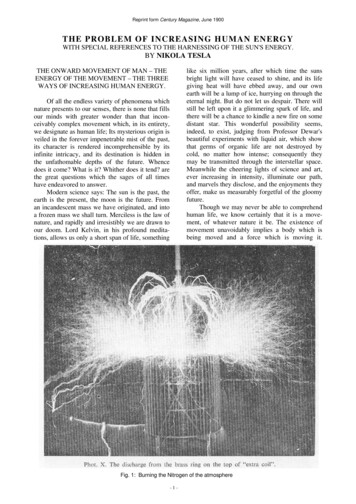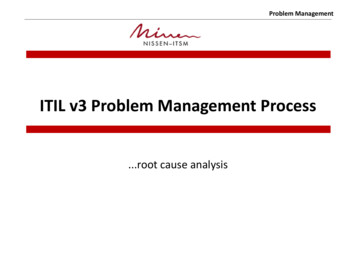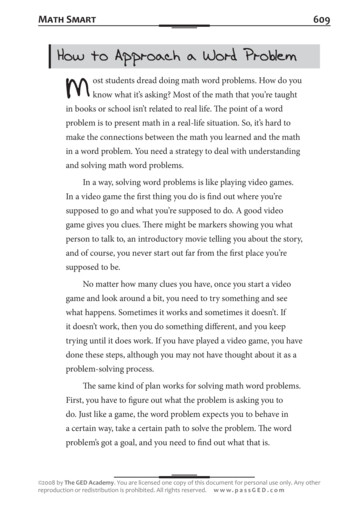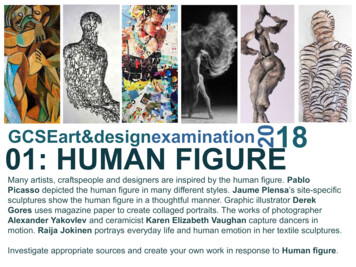
Transcription
Reprint form Century Magazine, June 1900THE PROBLEM OF INCREASING HUMAN ENERGYWITH SPECIAL REFERENCES TO THE HARNESSING OF THE SUN'S ENERGY.BY NIKOLA TESLATHE ONWARD MOVEMENT OF MAN – THEENERGY OF THE MOVEMENT – THE THREEWAYS OF INCREASING HUMAN ENERGY.like six million years, after which time the sunsbright light will have ceased to shine, and its lifegiving heat will have ebbed away, and our ownearth will be a lump of ice, hurrying on through theeternal night. But do not let us despair. There willstill be left upon it a glimmering spark of life, andthere will be a chance to kindle a new fire on somedistant star. This wonderful possibility seems,indeed, to exist, judging from Professor Dewar'sbeautiful experiments with liquid air, which showthat germs of organic life are not destroyed bycold, no matter how intense; consequently theymay be transmitted through the interstellar space.Meanwhile the cheering lights of science and art,ever increasing in intensity, illuminate our path,and marvels they disclose, and the enjoyments theyoffer, make us measurably forgetful of the gloomyfuture.Though we may never be able to comprehendhuman life, we know certainly that it is a movement, of whatever nature it be. The existence ofmovement unavoidably implies a body which isbeing moved and a force which is moving it.Of all the endless variety of phenomena whichnature presents to our senses, there is none that fillsour minds with greater wonder than that inconceivably complex movement which, in its entirety,we designate as human life; Its mysterious origin isveiled in the forever impenetrable mist of the past,its character is rendered incomprehensible by itsinfinite intricacy, and its destination is hidden inthe unfathomable depths of the future. Whencedoes it come? What is it? Whither does it tend? arethe great questions which the sages of all timeshave endeavored to answer.Modern science says: The sun is the past, theearth is the present, the moon is the future. Froman incandescent mass we have originated, and intoa frozen mass we shall turn. Merciless is the law ofnature, and rapidly and irresistibly we are drawn toour doom. Lord Kelvin, in his profound meditations, allows us only a short span of life, somethingFig. 1: Burning the Nitrogen of the atmosphere-1 -
Reprint form Century Magazine, June 1900Hence, wherever there is life, there is a massmoved by a force. All mass possesses inertia, allforce tends to persist. Owing to this universalproperty and condition, a body, be it at rest or inmotion, tends to remain in the same state, and aforce, manifesting itself anywhere and throughwhatever cause, produces an equivalent opposingforce, and as an absolute necessity of this it followsthat every movement in nature must be rhythmical.Long ago this simple truth was clearly pointed outby Herbert Spencer, who arrived at it through asomewhat different process of reasoning. It isborne out in everything we perceive--in the movement of a planet, in the surging and ebbing of thetide, in the reverberations of the air, the swingingof a pendulum, the oscillations of an electric current, and in the infinitely varied phenomena oforganic life. Does not the whole of human lifeattest to it? Birth, growth, old age, and death of anindividual, family, race, or nation, what is it all buta rhythm? All life-manifestation, then, even in itsmost intricate form, as exemplified in man, however involved and inscrutable, is only a movement,to which the same general laws of movementwhich govern throughout the physical universemust be applicable.Note to Fig. 1.--This result is produced by thedischarge of an electrical oscillator giving twelvemillion volts. The electrical pressure, alternatingone hundred thousand times per second, excites thenormally inert nitrogen, causing it to combine withthe oxygen. The flame-like discharge shown in thephotograph measures sixty-five feet across.When we speak of man, we have a conceptionof humanity as a whole, and before applying scientific methods to, the investigation of his movementwe must accept this as a physical fact. But cananyone doubt to-day that all the millions of individuals and all the innumerable types and characters constitute an entity, a unit? Though free tothink and act, we are held together, like the stars inthe firmament, with ties inseparable. These tiescannot be seen, but we can feel them. I cut myselfin the finger, and it pains me: this finger is part ofmy. I see a friend hurt, and it hurts me, too: myfriend and I are one. And now I see stricken downan enemy, a lump of matter which, of all the lumpsof matter in the universe, I care least for, and it stillgrieves me. Does this not prove that each of us isonly part of a whole?For ages this idea has been proclaimed in theconsummately wise teachings of religion, probablynot alone as a means of insuring peace and harmony among men, but as a deeply founded truth.The Buddhist expresses it in one way, the Christianin another, but both say the same: We are all one.Metaphysical proofs are, however, not the onlyones which we are able to bring forth in support ofthis idea. Science, too, recognizes this connectedness of separate individuals, though not quite in thesame sense as it admits that the suns, planets, andmoons of a constellation are one body, and therecan be no doubt that it will be experimentallyconfirmed in times to come, when our means andmethods for investigating psychical and otherstates and phenomena shall have been brought togreat perfection. Still more: this one human beinglives on and on. The individual is ephemeral, racesand nations come and pass away, but man remains.Therein lies the profound difference between theindividual and the whole. Therein, too, is to befound the partial explanation of many of thosemarvelous phenomena of heredity which are theresult of countless centuries of feeble but persistentinfluence.Conceive, then, man as a mass urged on by aforce. Though this movement is not of a translatorycharacter, implying change of place, yet the general laws of mechanical movement are applicable toit, and the energy associated with this mass can bemeasured, in accordance with well-known principles, by half the product of the mass with thesquare of a certain velocity. So, for instance, a cannon-ball which is at rest possesses a certain amountof energy in the form of heat, which we measure ina similar way. We imagine the ball to consist ofinnumerable minute particles, called atoms or molecules, which vibrate or whirl around one another.We determine their masses and velocities, andfrom them the energy of each of these minute systems, and adding them all together, we get an ideaof the total heat-energy contained in the ball,which is only seemingly at rest. In this purely theoretical estimate this energy may then be calculatedby multiplying half of the total mass--that is half ofthe sum of all the small masses--with the square ofa velocity which is determined from the velocitiesof the separate particles. In like manner we mayconceive of human energy being measured by halfthe human mass multiplied with the square of thevelocity which we are not yet able to compute. Butour deficiency in this knowledge will not vitiatethe truth of the deductions I shall draw, which reston the firm basis that the same laws of mass andforce govern throughout nature.Man, however, is not an ordinary mass, consisting of spinning atoms and molecules, andcontaining merely heat-energy. He is a mass possessed of certain higher qualities by reason of thecreative principle of life with which he is endowed.His mass, as the water in an ocean wave, is beingcontinuously exchanged, new taking the place ofthe old. Not only this, but he grows propagates,and dies, thus altering his mass independently,-2 -
Reprint form Century Magazine, June 1900both in bulk and density. What is most wonderfulof all, he is capable of increasing or diminishinghis velocity of movement by the mysterious powerhe possesses by appropriating more or less energyfrom other substance, and turning it into motiveenergy. But in any given moment we may ignorethese slow changes and assume that human energyis measured by half the product of man's mass withthe square of a certain hypothetical velocity. However we may compute this velocity, and whateverwe may take as the standard of its measure, wemust, in harmony with this conception, come to theconclusion that the great problem of science is, andalways will be, to increase the energy thus defined.dance with the preceding, the human energy willthen be given by the product ½ MV2 ½ MV x V,in which M is the total mass of man in the ordinaryinterpretation of the term "mass," and V is a certainhypothetical velocity, which, in the present state ofscience, we are unable exactly to define and determine. To increase the human energy is, therefore, equivalent to increasing this product, andthere are, as will readily be seen, only three wayspossible to attain this result, which are illustratedin the above diagram. The first way shown in thetop figure, is to increase the mass (as indicated bythe dotted circle), leaving the two opposing forcesthe same. The second way is to reduce the retarding force R to a smallervalue r, leaving the massand the impelling force thesame, as diagrammaticallyshown in the middle figure.The third way, which isillustrated in the last figure,is to increase the impellingforce f to a higher value F,while the mass and the retarding force R remainunaltered. Evidently fixedlimits exist as regardsincrease of mass andreduction of retardingforce, but the impelling force can be increased indefinitely. Each of these threepossible solutions presentsa different aspect of themain problem of increasingDIAGRAM a: The three ways of increasinghuman energy, which ishuman energy.thus divided into three distinct problems, to be successively considered.Many years ago, stimulated by the perusal of thatdeeply interesting work, Draper's "History of theTHE FIRST PROBLEM: HOW TO INCREASEIntellectual Development of Europe," depicting soTHE HUMAN MASS – THE BURNING OFvividly human movement, I recognized that tosolve this eternal problem must ever be the chiefATMOSPHERIC NITROGEN.task of the man of science. Some results of myown efforts to this end I shall endeavor briefly toViewed generally, there are obviously twodescribe here.ways of increasing the mass of mankind: first, byLet, then, in diagram a, M represent the massaiding and maintaining those forces and conditionsof man. This mass is impelled in one direction by awhich tend to increase it; and, second, by opposingforce f, which is resisted by another partly fricand reducing those which tend to diminish it. Thetional and partly negative force R, acting in amass will be increased by careful attention todirection exactly opposite, and retarding thehealth, by substantial food, by moderation, bymovement of the mass. Such an antagonistic forceregularity of habits, by promotion of marriage, byis present in every movement and must be takenconscientious attention to children, and, generallyinto consideration. The difference between thesestated, by the observance of all the many preceptstwo forces is the effective force which imparts aand laws of religion and hygiene. But in addingvelocity V to the mass M in the direction of thenew mass to the old, three cases again presentarrow on the line representing the force f. In accorthemselves. Either the mass added is of the same-3 -
Reprint form Century Magazine, June 1900velocity as the old, or it is of a smaller or of ahigher velocity. To gain an idea of the relativeimportance of these cases, imagine a train composed of, say, one hundred locomotives running ona track, and suppose that, to increase the energy ofthe moving mass, four more locomotives are addedto the train. If these four move at the same velocityat which the train is going, the total energy will beincreased four per cent.; if they are moving at onlyone half of that velocity, the increase will amountto only one per cent.; if they are moving at twicethat velocity, the increase of energy will be sixteenper cent. This simple illustration shows that it is ofgreatest importance to add mass of a higher velocity. Stated more to the point, if, for example, thechildren be of the same degree of enlightenment asthe parents,--that is, mass of the "same velocity,"-the energy will simply increase proportionately tothe number added. If they are less intelligent oradvanced, or mass of "smaller velocity," there willbe a very slight gain in the energy; but if they arefurther advanced, or mass of "higher velocity,"then the new generation will add very considerablyto the sum total of human energy. any addition ofmass of "smaller velocity," beyond that indispensable amount required by the law expressed in theproverb, "Mens sana in corpore sano," should bestrenuously opposed. For instance, the mere development of muscle, as aimed at in some of ourcolleges, I consider equivalent to adding mass of"smaller velocity," and I would not commend it,although my views were different when I was astudent myself. Moderate exercise, insuring theright balance between mind and body, and thehighest efficiency of performance, is, of course, aprime requirement. The above example shows thatthe most important result to be attained is theeducation, or the increase of the "velocity," of themass newly added.Conversely, it scarcely need be stated thateverything that is against the teachings of religionand the laws of hygiene is tending to decrease themass. Whisky, wine, tea coffee, tobacco, and othersuch stimulants are responsible for the shorteningof the lives of many, and ought to be used withmoderation. But I do not think that rigorous measures of suppression of habits followed throughmany generations are commendable. It is wiser topreach moderation than abstinence. We havebecome accustomed to these stimulants, and ifsuch reforms are to be effected, they must be slowand gradual. Those who are devoting their energiesto such ends could make themselves far moreuseful by turning their efforts in other directions,as, for instance, toward providing pure water.For every person who perishes from the effects of a stimulant, at least a thousand die fromthe consequences of drinking impure water. Thisprecious fluid, which daily infuses new life into us,is likewise the chief vehicle through which diseaseand death enter our bodies. The germs of destruction it conveys are enemies all the more terrible asthey perform their fatal work unperceived. Theyseal our doom while we live and enjoy. The majority of people are so ignorant or careless indrinking water, and the consequences of this are sodisastrous, that a philanthropist can scarcely usehis efforts better than by endeavoring to enlightenthose who are thus injuring themselves. By systematic purification and sterilization of the drinking water the human mass would be very considerably increased. It should be made a rigid rule-which might be enforced by law--to boil or tosterilize otherwise the drinking water in everyhousehold and public place. The mere filteringdoes not afford sufficient security against infection. All ice for internal uses should be artificiallyprepared from water thoroughly sterilized. Theimportance of eliminating germs of disease fromthe city water is generally recognized, but little isbeing done to improve the existing conditions, asno satisfactory method of sterilizing great quantities of water has yet been brought forward. Byimproved electrical appliances we are now enabledto produce ozone cheaply and in large amounts,and this ideal disinfectant seems to offer a happysolution of the important question.Gambling, business rush, and excitement,particularly on the exchanges, are causes of muchmass reduction, all the more so because the individuals concerned represent units of higher value.Incapacity of observing the first symptoms of anillness, and careless neglect of the same, are important factors of mortality. In noting carefullyevery new sign of approaching danger, and makingconscientiously every possible effort to avert it, weare not only following wise laws of hygiene in theinterest of our well-being and the success of ourlabors, but we are also complying with a highermoral duty. Everyone should consider his body asa priceless gift from one whom he loves above all,as a marvelous work of art, of indescribable beautyand mastery beyond human conception, and sodelicate and frail that a word, a breath, a look, nay,a thought, may injure it. Uncleanness, whichbreeds disease and death, is not only a self destructive but highly immoral habit. In keeping ourbodies free from infection, healthful, and pure, weare expressing our reverence for the high principlewith which they are endowed. He who follows theprecepts of hygiene in this spirit is proving himself, so far, truly religious. Laxity of morals is aterrible evil, which poisons both mind and body,and which is responsible for a great reduction of-4 -
Reprint form Century Magazine, June 1900the human mass in some countries. Many of thepresent customs and tendencies are productive ofsimilar hurtful results. For example, the societylife, modern education and pursuits of women,tending to draw them away from their householdduties and make men out of them, must needsdetract from the elevating ideal they represent,diminish the artistic creative power, and causesterility and a general weakening of the race. Athousand other evils might be mentioned, but allput together, in their bearing upon the problemunder discussion, they could not equal a single one,the want of food, brought on by poverty, destitution, and famine. Millions of individuals die yearlyfor want of food, thus keeping down the mass.Even in our enlightened communities, and notwithstanding the many charitable efforts, this isstill, in all probability, the chief evil. I do not meanhere absolute want of food, but want of healthfulnutriment.How to provide good and plentiful food is,therefore, a most important question of the day. Onthe general principles the raising of cattle as ameans of providing food is objectionable, because,in the sense interpreted above, it must undoubtedlytend to the addition of mass of a "smaller velocity."It is certainly preferable to raise vegetables, and Ithink, therefore, that vegetarianism is a commendable departure from the established barbaroushabit. That we can subsist on plant food and perform our work even to advantage is not a theory,but a well-demonstrated fact. Many races livingalmost exclusively on vegetables are of superiorphysique and strength. There is no doubt that someplant food, such as oatmeal, is more economicalthan meat, and superior to it in regard to bothmechanical and mental performance. Such food,moreover, taxes our digestive organs decidedlyless, and, in making us more contented and sociable, produces an amount of good difficult to estimate. In view of these facts every effort should bemade to stop the wanton and cruel slaughter ofanimals, which must be destructive to our morals.To free ourselves from animal instincts and appetites, which keep us down, we should begin at thevery root from which we spring: we should effect aradical reform in the character of the food.There seems to be no philosophical necessityfor food. We can conceive of organized beingsliving without nourishment, and deriving all theenergy they need for the performance of their lifefunctions from the ambient medium. In a crystalwe have the clear evidence of the existence of aformative life-principle, and though we cannotunderstand the life of a crystal, it is none the less aliving being. There may be, besides crystals, othersuch individualized, material systems of beings,perhaps of gaseous constitution, or composed ofsubstance still more tenuous. In view of this possibility,--nay, probability, we cannot apodicticallydeny the existence of organized beings on a planetmerely because the conditions on the same areunsuitable for the existence of life as we conceiveit. We cannot even, with positive assurance, assertthat some of them might not be present here, in thisour world, in the very midst of us, for their constitution and life-manifestation may be such that weare unable to perceive them.The production of artificial food as a meansfor causing an increase of the human mass naturally suggests itself, but a direct attempt of thiskind to provide nourishment does not appear to merational, at least not for the present. Whether wecould thrive on such food is very doubtful. We arethe result of ages of continuous adaptation, and wecannot radically change without unforeseen and, inall probability, disastrous consequences. So uncertain an experiment should not be tried. By farthe best way, it seems to me, to meet the ravages ofthe evil, would be to find ways of increasing theproductivity of the soil. With this object the preservation of forests is of an importance whichcannot be overestimated, and in this connection,also, the utilization of water-power for purposes ofelectrical transmission, dispensing in many wayswith the necessity of burning wood, and tendingthereby to forest preservation, is to be stronglyadvocated. But there are limits in the improvementto be effected in this and similar ways.To increase materially the productivity of thesoil, it must be more effectively fertilized byartificial means. The question of food-productionresolves itself, then, into the question how best tofertilize the soil. What it is that made the soil isstill a mystery. To explain its origin is probablyequivalent to explaining the origin of life itself.The rocks, disintegrated by moisture and heat andwind and weather, were in themselves not capableof maintaining life. Some unexplained conditionarose, and some new principle came into effect,and the first layer capable of sustaining low organisms, like mosses was formed. These, by theirlife and death, added more of the life sustainingquality to the soil, and higher organisms could thensubsist, and so on and on, until at last highly developed plant and animal life could flourish. Butthough the theories are, even now, not in agreement as to how fertilization is effected, it is a fact,only too well ascertained, that the soil cannotindefinitely sustain life, and some way must befound to supply it with the substances which havebeen abstracted from it by the plants. The chief andmost valuable among these substances are compounds of nitrogen, and the cheap production of-5 -
Reprint form Century Magazine, June 1900these is, therefore, the key for the solution of theall-important food problem. Our atmosphere contains an inexhaustible amount of nitrogen, andcould we but oxidize it and produce these compounds, an incalculable benefit for mankind wouldfollow.Long ago this idea took a powerful hold onthe imagination of scientific men, but an efficientmeans for accomplishing this result could not bedevised. The problem was rendered extremelydifficult by the extraordinary inertness of the nitrogen, which refuses to combine even with oxygen.But here electricity comes to our aid: the dormantaffinities of the element are awakened by anelectric current of the proper quality. As a lump ofcoal which has been in contact with oxygen forcenturies without burning will combine with itwhen once ignited, so nitrogen, excited by electricity, will burn. I did not succeed, however, inproducing electrical discharges exciting veryeffectively the atmospheric nitrogen until a comparatively recent date, although I showed, in May,1891, in a scientific lecture, a novel form of discharge or electrical flame named "St. Elmo'shotfire," which, besides being capable of generating ozone in abundance, also possessed, as Ipointed out on that occasion, distinctly the qualityof exciting chemical affinities. This discharge orflame was then only three or four inches long, itschemical action was likewise very feeble, andconsequently the process of oxidation of nitrogenwas wasteful. How to intensify this action was thequestion. Evidently electric currents of a peculiarkind had to be produced in order to render theprocess of nitrogen combustion more efficient.The first advance was made in ascertainingthat the chemical activity of the discharge was veryconsiderably increased by using currents of extremely high frequency or rate of vibration. Thiswas an important improvement, but practicalconsiderations soon set a definite limit to theprogress in this direction. Next, the effects of theelectrical pressure of the current impulses, of theirwave-form and other characteristic features, wereinvestigated. Then the influence of the atmosphericpressure and temperature and of the presence ofwater and other bodies was studied, and thus thebest conditions for causing the most intensechemical action of the discharge and securing thehighest efficiency of the process were graduallyascertained. Naturally, the improvements were notquick in coming; still, little by little, I advanced.The flame grew larger and larger, and its oxidizingaction grew more intense. From an insignificantbrush-discharge a few inches long it developedinto a marvelous electrical phenomenon, a roaringblaze, devouring the nitrogen of the atmosphereand measuring sixty or seventy feet across. Thusslowly, almost imperceptibly, possibility becameaccomplishment. All is not yet done, by anymeans, but to what a degree my efforts have beenrewarded an idea may be gained from an inspection of Fig. 1 (p. 176), which, with its title, is selfexplanatory. The flame-like discharge visible isproduced by the intense electrical oscillationswhich pass through the coil shown, and violentlyagitate the electrified molecules of the air. By thismeans a strong affinity is created between the twonormally indifferent constituents of the atmosphere, and they combine readily, even if no furtherprovision is made for intensifying the chemicalaction of the discharge. In the manufacture ofnitrogen compounds by this method, of course,every possible means bearing upon the intensity ofthis action and the efficiency of the process will betaken advantage of, and, besides, special arrangements will be provided for the fixation of thecompounds formed, as they are generally unstable,the nitrogen becoming again inert after a littlelapse of time. Steam is a simple and effectivemeans for fixing permanently the compounds. Theresult illustrated makes it practicable to oxidize theatmospheric nitrogen in unlimited quantities,merely by the use of cheap mechanical power andsimple electrical apparatus. In this manner manycompounds of nitrogen may be manufactured allover the world, at a small cost, and in any desiredamount, and by means of these compounds the soilcan be fertilized and its productiveness indefinitelyincreased. An abundance of cheap and healthfulfood, not artificial, but such as we are accustomedto, may thus be obtained. This new and inexhaustible source of food-supply will be of incalculablebenefit to mankind, for it will enormously contribute to the increase of the human mass, and thus addimmensely to human energy. Soon, I hope, theworld will see the beginning of an industry which,in time to come, will, I believe, be in importancenext to that if iron.THE SECOND PROBLEM: HOW TO REDUCETHE FORCE RETARDING THE HUMANMASS – THE ART OF TELAUTOMATICS.As before stated, the force which retards theonward movement of man is partly frictional andpartly negative. To illustrate this distinction I mayname, for example, ignorance, stupidity, andimbecility as some of the purely frictional forces,or resistances devoid of any directive tendency. Onthe other hand, visionariness, insanity, self-destructive tendency, religious fanaticism, and thelike, are all forces of a negative character, acting indefinite directions. To reduce or entirely overcome-6 -
Reprint form Century Magazine, June 1900these dissimilar retarding forces, radically differentmethods must be employed. One knows, for instance, what a fanatic may do, and one can takepreventive measures, can enlighten, convince, and,possibly direct him, turn his vice into virtue; butone does not know, and never can know, what abrute or an imbecile may do, and one must dealwith him as with a mass, inert, without mind, letloose by the mad elements. A negative force always implies some quality, not infrequently a highone, though badly directed, which it is possible toturn to good advantage; but a directionless, frictional force involves unavoidable loss. Evidently,then, the first and general answer to the abovequestion is: turn all negative force in the rightdirection and reduce all frictional force.There can be no doubt that, of all the frictionalresistances, the one that most retards humanmovement is ignorance. Not without reason saidthat man of wisdom, Buddha: "Ignorance is thegreatest evil in the world." The friction whichresults from ignorance, and which is greatly increased owing to the numerous languages andnationalities, can be reduced only by the spread ofknowledge and the unification of the heterogeneous elements of humanity. No effort could bebetter spent. But however ignorance may haveretarded the onward movement of man in timespast, it is certain that, nowadays, negative forceshave become of greater importance. Among thesethere is one of far greater moment than any other.It is called organized warfare. When we considerthe millions of individuals, often the ablest in mindand body, the flower of humanity, who are compelled to a life of inactivity and unproductiveness,the immense sums of money daily required for themaintenance of armies and war apparatus, representing ever so much of human energy, all theeffort uselessly spent in the production of arms andimplements of destruction, the loss of life and thefostering of a barbarous spirit, we are appalled atthe inestimable loss to mankind which the existence of these deplorable conditions must involve.
BY NIKOLA TESLA THE ONWARD MOVEMENT OF MAN – THE ENERGY OF THE MOVEMENT – THE THREE WAYS OF INCREASING HUMAN ENERGY. . Though free to think and act, we are held together, like the stars in the firmament, with ties inseparable. These ties cannot be seen, but we can feel them. I cu










